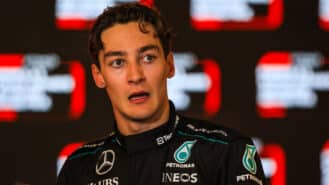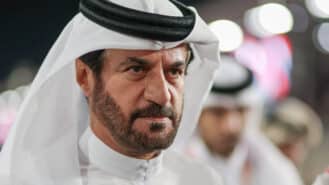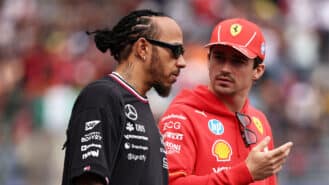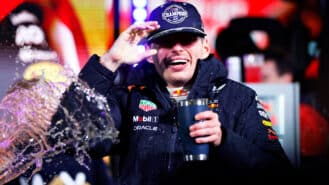
Verstappen proves Russell right: Abu Dhabi GP 2024 – Up/Down
Verstappen's prang at the first corner of the F1 finale in Abu Dhabi vindicated George Russell's recent rant
International rallying was a different beast in 1973. That year’s Daily Mirror-sponsored RAC was contested by 198 crews over five days and 70 stages; it would have been 80 stages but for PR concessions to the Oil Crisis.
Its top 20 included works entries from Ford, Saab, Alpine-Renault – winner of the inaugural World Championship for Manufacturers – BMW, Datsun, Toyota, Opel, Lancia and Fiat.
Beyond the top 20 lay Chryslers, Morris’, Volvos, Vauxhalls, DAFs, Hillmans, Porsches, Wartburgs, Simcas, Triumphs, Renaults, Skodas and VWs, plus singular representatives of Alfa Romeo, Austin, Citroën, Honda, Mazda, MG, Moskvitch and Peugeot.
Also beyond the top 20 were drivers of the calibre of Chris Sclater, Walter Röhrl, Shekhar Mehta, Vic Preston Jr, Billy Coleman and, seeded at 60 in a Group 1 Avenger, Andy Dawson.
The event, though long and arduous – looping, from two overnight halts at its York Racecourse HQ, through mid- and north Wales, then The Lakes, western Scotland and Kielder, and finally North Yorkshire – was inclusive.
More than two million spectators lined its route. Only the hardcore, however, would have heard of the gangly 22-year-old Finn, seeded 18, in a Motorcraft-sponsored Ford Escort RS1600.
Click here to vote on the Hall of Fame Nominees
Helsinki-born Markku Alén was already big news back home because of his nimble handling of Volvo’s bulky 142; he’d finished second in August’s 1000 Lakes Rally, the occasion of his World Championship debut.
It was also the occasion of his first meeting with David Sutton, a man with a burgeoning reputation as a sub-contracted builder and preparer of works rally Fords. According to Sutton, Alén’s only words of English at the time were ‘left’, ‘right’, ‘vodka’ and ‘tonic’ – but they struck a deal for the RAC.

By way of preparation Alén was entered in October’s Lindisfarne Rally, a round of the British Championship, where he was co-driven by the vastly experienced Henry Liddon. Though they went OTL at mid-distance because of a suspension – some say steering – problem, Liddon was impressed and Sutton’s phone was ringing off the hook come Monday morning.
Liddon was unavailable for the main event – he was Timo Mäkinen’s regular co-driver – and a replacement was selected on the basis of a fluency in English and Finnish. Thus was born one of the sport’s most enduring partnerships. Inseparable thereafter, Alén and Ilkka Kivimäki – the rock over which his driver’s stormy temperament so often broke – were still winning at the highest level 15 years later.
Ford’s British champion Roger Clark, winner of the Lindisfarne Rally – for which he received £150 – was first down the York start ramp and set the early pace despite a heavy cold.
Saturday’s fourth and fifth tests had been cancelled and so the field cut directly to a slippery but fast, mixed-surface stage at Sutton Park, north of Birmingham. This Mickey Mouse stage would play a big part in the outcome of the rally.
First, it Donald Duck-ed Hannu Mikkola’s hand when he crashed his works Escort RS1600. Then Alén crashed at the same corner, spent more than five minutes regaining the road – during which time Tony Fall’s Datsun 240Z flew over the stranded Escort’s boot – and plunged to 177th.
![]()

Alén won the FIA Cup for Drivers in 1978
The damage hampered Alén throughout the first leg and his charge did not begin in earnest until the Monday resumption – not at Bradford’s Esholt sewage works, or in Manchester’s Heaton Park, but at SS40, Grizedale, in the Lake District.
Mäkinen was by now controlling the lead he had established with 12 fastest stage times in Wales. There was, however, plenty of reason for Clark to continue to push in his battle for second place with the BMW 2002 of Björn Waldegård – yet it was Alén who starred in the rally’s second half.
He was fastest through Dunnerdale, too, Ennerdale and Tinnisburn, Ae West, Kirroughtree, Glentress and Craik. He was fastest on five of the seven ‘Killer’ Kielder stages and in Hamsterley.
Click here to vote on the Hall of Fame Nominees
He continued to top the timesheets on Wednesday’s short final leg: Broxa, Langdale, Staindale and Dalbys North and South – the latter the rally’s longest stage at 15 miles – and on its final stage, Cropton, he set his 20th fastest time, one more than Mäkinen; Clark was fastest on 10.
There had, however, been a twist in the tail.
![]()

Alén was a fan of Lancia’s 037
Waldegård crashed down a bank in Pickering, the penultimate stage, and his BMW’s rescue, which involved the felling of several saplings, was being overseen by Russell Brookes and his co-driver John Brown – spectating because their Escort had gone end over end on the opening day – when Alén arrived, somewhat awry, on the scene. The Escort was manhandled to a lower section of road and sent on its way, minus rear windscreen and with a crushed boot.
Alén finished third, three minutes behind Clark, eight behind Makinen – and suddenly he was hot property.
Ford got in first – Alén would win the 1974 Welsh Rally in an Escort – but the Blue Oval had too many Finns for too few rallies. Fiat in contrast offered a fuller programme and a more lucrative contract.
That was the hook. But it went much deeper. Although Alén can’t have known that their relationship would last until 1990, this most charismatic of drivers, as compelling out of the cockpit as within it – staccato in speech, glissando at the wheel – must have known that he was fundamentally suited to Turin rather than Boreham.
Though Finnish from the fingertips of his driving gloves to the seat of his pants, he was Latin in many other respects; Ford showed him (to) the rest of the world but the Fiat Group provided a home from home.
![]()

Alén’s final victory came in Britain in 1988
PS Other stage winners on the 1973 RAC Rally included Stig Blomqvist, Per Eklund and Simo Lampinen – all in works Saabs – Waldegård, Jean-Pierre Nicolas, Donald Heggie, Ove Andersson, Leif Asterhag, Amilcare Ballestrieri, Sergio Barbasio, Chris Beynon, Pete Doughty, Drew Gallacher, Marek Gierowski, Röhrl, Graham Taylor, Kevin Videan, Per-Inge Walfridsson and Christopher Wathen
Swedes, Italians, English clubmen, Scottish clubmen, a Frenchman, a German and a Pole representing between them: BMW, Alpine-Renault, Ford, Toyota, Lancia, Fiat, Porsche, Opel, Datsun and Volvo; front-engine rear-wheel drive, rear-engine rear-wheel-drive and front-engine front-wheel drive.
International rallying was indeed a very different beast.

Verstappen's prang at the first corner of the F1 finale in Abu Dhabi vindicated George Russell's recent rant

FIA president Mohammed Ben Sulayem seemed intent on making F1 a united front by the end of the 2024 Qatar GP – against him

Leclerc erupted after feeling wronged one time too many by Sainz in Vegas – but the challenge posed by his team-mate next year, Lewis Hamilton, will be much greater writes James Elson

2024 has been Max Verstappen's masterclass – it should go down in history as one of F1's greatest titles